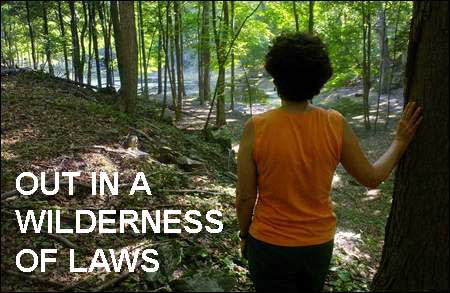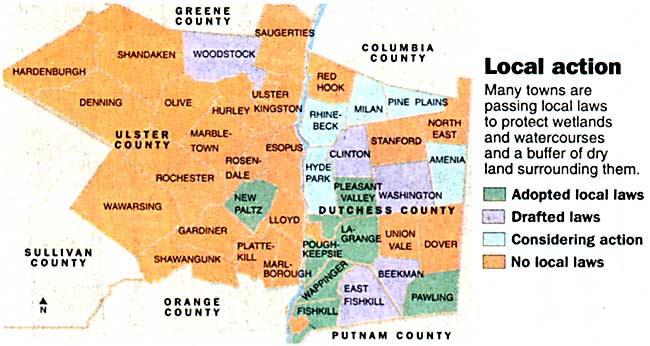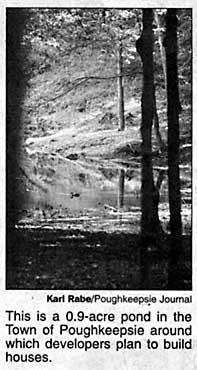
August 6, 2006
PRESERVING OUR WETLANDS

Doreen Tignanelli of the Town of Poughkeepsie looks at a pond
around which developers are planning to build homes
Lack of federal, state oversight leaves towns no option but to make own rules
Water: Extent of buffer zones is issue
Story by DAN SHAPLEY
Photo by KARL RABE
Poughkeepsie Journal
Picture a nameless little pond, just under one acre in size, set back in
the woods.
Wildlife like frogs, turtles and ducks might live there. During heavy
rain, it might accumulate water that would otherwise flood nearby
basements or roads.
In Poughkeepsie, the owner of that pond would need a permit — and good
reason — to drain or fill the wetland.
In Pawling, he would have to preserve a 100-foot buffer of undisturbed
plants and trees around a similar pond.
Landowners in many other local towns could do whatever they please to a
pond that size.
In the absence of federal or state laws protecting many small wetlands,
six local towns have passed laws in an attempt to fill the gap.
Five more have drafted laws and five others are in the process of
drafting their own. Others have some zoning restrictions governing
wetlands, or plan to increase protections as they update their master
plans and zoning codes.
No two laws are identical.

Scrutiny varies across region
The patchwork of protection means many small wetlands can be filled,
drained or encroached upon with varying degrees of scrutiny from local
officials charged with looking out for the common good. Because water
doesn't stop flowing at municipal boundaries, upstream towns may be
jeopardizing the water quality of communities downstream.
It also means landowners and developers seeking to alter their
properties face a dizzying variety of local ordinances from one town to
the next.
Landowners have challenged several local laws, claiming they infringed
on their rights to make decisions about — and maximize profit on — their
properties.
In Woodstock, for instance, Wittenberg Sportsman's Club successfully
challenged a wetlands protection law, prompting the town to rewrite it.
"We're looking at filling in regulatory gaps," said Dara Trahan, a
planning specialist for the Woodstock planning board. "We've lost many
of our wetlands that were supposedly national inventory wetlands. Nobody
said boo. ... We've been approving lots that are 50 percent wetlands.
Our hands are kind of tied."
Calls to the hunting club were not returned.
Studies list advantages
Wetlands are ponds, swamps, bogs, fens and other areas where water
accumulates. Studies have documented the way they limit flooding,
cleanse some pollutants, replenish groundwater supplies and provide
habitat for a variety of wildlife.
Since the Clean Water Act of 1972, the federal government has recognized
their importance, and set up a system to protect wetlands across the
nation. Many states, including New York, enacted laws that increased
protection further.
A 2001 Supreme Court decision narrowed the federal government's
jurisdiction over small wetlands, restricting the Army Corps of
Engineers' oversight to wetlands connected to navigable bodies of water.
The decision removed protection for as many as two thirds of the
wetlands in central Dutchess County, according to a Fish and Wildlife
inventory.
A 2006 Supreme Court decision further confused the interpretation of
federal jurisdiction over small wetlands. The Army Corps of Engineers
rarely denies a permit for draining or filling a small wetland, but it
often requires changes to a project to limit the impact.
Since 1975, New York has regulated wetlands of at least 12.4 acres — one
hectare — and a 100-foot buffer surrounding them.
Stuck in Senate
The Assembly passed a bill expanding protection to smaller wetlands this
year. It had the support of Gov. George Pataki, but the Senate
leadership refused to bring it up for a vote.
Environmentalists and, increasingly, waterfowl hunters, have lobbied to
increase protection. New York has lost an estimated 60 percent of its
original wetlands — a figure that is similar to the national percentage.
The loss of any one wetland may affect little, but the loss of many
across the landscape can degrade the quality of groundwater, streams,
creeks and even the Hudson River.
The loss of wetlands, as well as the increased runoff from new roads,
driveways and rooftops, has likely contributed to a measurable decline
in the water quality of formerly pristine Hudson Valley streams in
recent years.
The loss of consistent wetlands protections has come at a time when
development is fast consuming open land in the Hudson Valley, and local
officials say developers increasingly want to build on land with
wetlands and steep slopes.
"We see that more and more in our towns because the developable land —
at least the prime developable land — is taken," said Mike Appolonia, a
councilman in the Town of Clinton, which drafted a wetlands protection
law this summer.
"We're getting now to the types of lands, particularly in Clinton, which
are really undesirable and yet desirable from the standpoint of someone
who wants a house on it."
Population increasing
Of the nearly 80,000 people who moved into the Hudson Valley between
2000 and 2005, 75 percent moved into relatively rural areas outside
established cities and villages.
In Dutchess County, the second-fastest growing county in the Hudson
Valley behind Orange County, 94 percent of the population growth is
dispersed in its more rural areas.
That suburban sprawl may con-sume wetlands, farms and other open spaces,
but the market for new houses has only recently slackened slightly after
five years of explosive growth. People want to buy the houses developers
are building.
Stringent laws sought
Others see restrictive, rigid laws as the only way to preserve wetlands.

In the woods behind Doreen Tignanelli's house in the Town of
Poughkeepsie is a 0.9-acre pond and a larger state-regulated wetland
on the 56-acre former Girl Scout camp, Forest Glen Nature Sanctuary.
The landowner, Harold Buchner, who did not return phone calls last week,
has plans to build as many as 39 homes on his property.
Poughkeepsie's 2003 wetlands protection law struck a compromise
between the desires of environmentalists and builders. A graduated
system requires a greater buffer around larger wetlands, and smaller
buffers around smaller wetlands. At less than an acre, the pond in
Forest Glen requires no buffer.
Tignanelli, member of the town's conservation advisory council, said
that compromise ignored scientific evidence that buffers are needed to
sustain many species. Studies have shown, for instance, that frogs need
substantial forests surrounding the ponds where they breed in order to
survive.
"It's one of the few remaining spots in the Town of Poughkeepsie
that's a refuge for wildlife. It's a sanctuary," she said. "The buffer
sizes are not adequate."
QUOTABLE
WETLANDS PROTECTION
'You have to draw a distinction between regulating and confiscating
land. If something is proposed in the buffer, the applicant would have
to have a pretty good reason to encroach into the buffer to get that
permit.'
Joachim Ansorge
wetlands administrator
LaGrange
'The interesting part is, the (state and federal) laws that are on the
books right now, if you abide by them and go through the appropriate
method of determining what the wetland is, they work.'
John Coutant
Esopus supervisor
'We have a big property rights advocacy in this town, so we're not
pushing the envelope right now. We're pushing education.'
Robert Gallagher
Rosendale supervisor
'We have golf courses in town, so we have to be careful to understand
their need for pesticides. They, on the other hand, have to understand
our needs to protect water.'
John Hickman
East Fishkill supervisor
'If everybody likes this law, I've done a lousy job.'
Frank Marglotta
co-chairman
Milan conservation advisory council
'It's a process, and if you don't have an environmental community group,
like a conservation advisory council, it's hard to create a wetlands law
out of the blue.'
Mary McNamera
coordinator
Sawkill Watershed Alliance
'The town of Red Hook, which has been a model in other areas of open
space preservation, needs to step up to the plate, and resolve itself to
address these smaller bodies of water, and the unequivocal reality that
they are becoming more and more polluted as development marches on.'
Robert McKeon
chairman
Red Hook Farmland and Open Space Committee
'You're looking at three — federal, local and state — three separate
agencies. There's no one-stop shopping, one-stop permitting. That's a
time-consuming issue.'
Tim Villnskis
vice president
Builders Association of the Hudson Valley
'We have the Great Swamp, so we recognize the role wetlands play. ...
We've tried to build in water protection generally into our code.'
Jill Way
Dover supervisor



